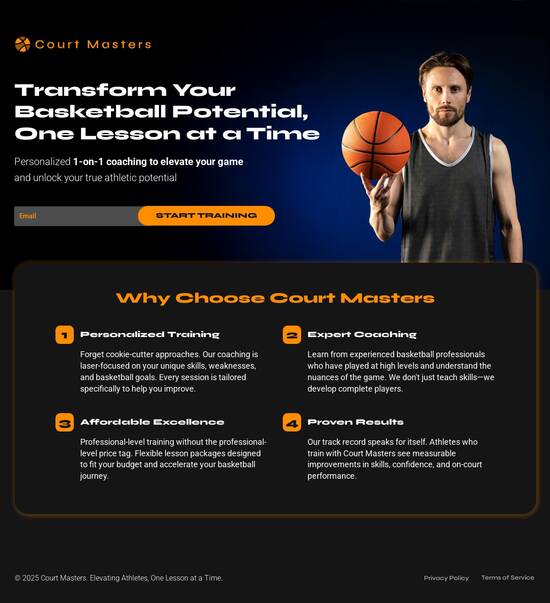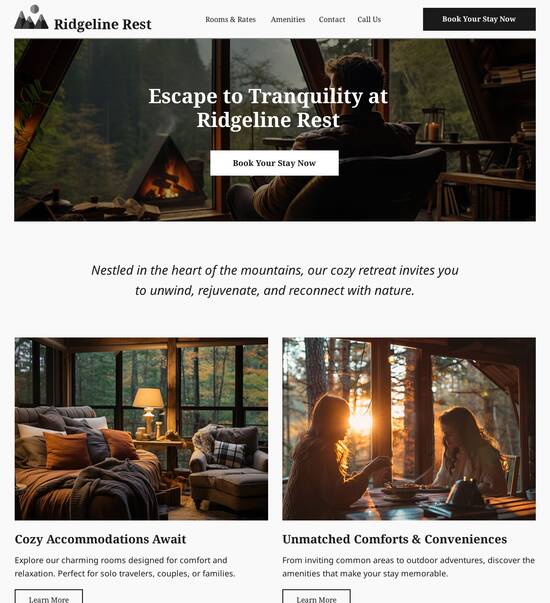
Modern product listing page template
Explore Similar TemplatesAbout template
Unleash your creativity with the modern product listing page template. Try Instapage today.
Recommended templates

Easy to build without coding
With the intuitive drag-and-drop builder, anyone on your team can create high-converting pages without any knowledge of code or design. Make enhancements to your landing page with custom widgets using Javascript, HTML/CSS, or third-party scripts.

Multiple layouts for any industry and goal
Select from 500+ landing page layouts built to boost conversions across industry-specific scenarios. Customize them by adjusting fonts, adding images, and generating on-brand content with the AI assistant. Quickly scale with Instablocks® and Global Blocks that you can save, reuse, and update globally.

Loads fast and looks polished on any device
Every template is responsive, which means they present professionally on any device and load blazingly fast with our Thor Render Engine. You can also power them up with Google AMP technology to deliver an unparalleled mobile experience and drive higher conversions.

Robust analytics & experimentation
Get real-time updates and reporting across all your devices, showing the number of visitors, conversions, cost-per-visitor, and cost-per-lead. Launch AI-powered experiments, run A/B tests, and use heatmaps to analyze user behavior, then optimize your landing page to maximize conversions.







Easy to build without coding
With the intuitive drag-and-drop builder, anyone on your team can create high-converting pages without any knowledge of code or design. Make enhancements to your landing page with custom widgets using Javascript, HTML/CSS, or third-party scripts.
Multiple layouts for any industry and goal
Select from 500+ landing page layouts built to boost conversions across industry-specific scenarios. Customize them by adjusting fonts, adding images, and generating on-brand content with the AI assistant. Quickly scale with Instablocks® and Global Blocks that you can save, reuse, and update globally.
Loads fast and looks polished on any device
Every template is responsive, which means they present professionally on any device and load blazingly fast with our Thor Render Engine.
Robust analytics & experimentation
Get real-time updates and reporting across all your devices, showing the number of visitors, conversions, cost-per-visitor, and cost-per-lead. Launch AI-powered experiments, run A/B tests, and use heatmaps to analyze user behavior, then optimize your landing page to maximize conversions.
All the features you need to build lead-generating landing pages
Explore more featuresLearn how to build top-performing landing pages for any goal
FAQs
Leading the way in building high-performing landing pages





A step-by-step guide to crafting high-converting landing pages with Instapage
Creating high-impact landing pages is crucial for maximizing your marketing ROI, especially for businesses in sectors like marketing and advertising, tech/SaaS, and education. Instapage stands out as a versatile landing page and conversion rate optimization platform, designed to help marketers efficiently build and optimize landing pages. This guide will walk you through the process of leveraging Instapage's powerful features to enhance your digital campaigns effectively.
Understanding the basics of landing pages
Landing pages serve as dedicated web pages that attract visitors and encourage specific actions, such as signing up for newsletters or making a purchase. They are essential in guiding your audience towards a unique goal, thereby increasing conversion rates. Understanding how to tailor these pages to meet the needs of various audiences is key to successful digital marketing.
- Conversion-focused templates: Instapage provides over 100 templates designed to convert visitors, allowing marketers to create pages quickly without starting from scratch.
- No coding required: With a user-friendly drag-and-drop interface, building landing pages becomes a straightforward task for marketers, regardless of their technical skill level.
- Optimization tools: Features like A/B testing and heatmaps enable marketers to analyze performance effectively and make data-driven improvements.
Step 1: Choosing the right template
Selecting a template that aligns with your campaign goals is crucial. Instapage offers a diverse range of customizable templates that cater to different industries, allowing you to hit the ground running.
- Assess your target audience: Tailor your choice based on the specific needs and behaviors of your audience.
- Consider your primary goal: Whether it's lead generation or sales, the template should encourage the desired action.
- Utilize personalization options: Opt for templates that allow dynamic text replacement to personalize user experiences.
Step 2: Crafting compelling content
Once you've chosen a template, it's time to focus on content. Engaging copy and attractive visuals are key to capturing attention and driving action.
- Write succinct headlines: Effective headlines communicate the benefit of your offer directly.
- Use clear calls to action (CTAs): Guide users on the next steps clearly and concisely.
- Incorporate visuals: Relevant images or videos can enhance engagement and convey your message quickly.
Step 3: Leveraging optimization tools
The final step involves optimizing your landing page for better performance using Instapage's built-in tools. Continuous testing and refinements will ensure your landing page remains effective.
- Employ A/B testing: Test different variations of headlines, images, and CTAs to see what resonates best with your audience.
- Analyze heatmaps: Collect data on user interactions to identify areas of improvement.
- Regularly monitor analytics: Keep track of conversion rates and user behavior to iterate upon your designs.
Following these steps will empower marketers to create landing pages that do not only look great but also drive conversions effectively.
Start transforming your digital marketing campaigns today by embracing Instapage's powerful landing page capabilities. Sign up for a free trial and discover the difference!
People also ask about Modern product listing page template
Modern product listing page templates: Enhancing your ecommerce experience
Understanding modern product listing page templates
Modern product listing page templates are integral elements of ecommerce websites. They serve as the first point of interaction between your customers and the products you offer. An effective template showcases products in a way that is visually appealing and easy to navigate. This is crucial because the way products are presented can significantly influence a buyer’s decision-making process. A well-designed product listing page can effectively communicate relevant information about products while maintaining an attractive and user-friendly interface.
The importance of modern product listing pages lies in their ability to drive conversions. These pages play a pivotal role in the customer journey, helping them find products easily and quickly. When users encounter a well-structured layout, intuitive filters, and responsive design, they are more likely to make a purchase. Furthermore, these templates enhance the user experience by ensuring that visitors can access product details seamlessly, thus fostering a positive relationship between the shopper and the brand.
Definition of product listing page templates in ecommerce.
Role of modern product listing pages in driving conversions.
How these templates enhance user experience (UX).
Key characteristics of modern templates
Key characteristics of modern product listing templates include their adherence to responsive design principles. In a world where users access websites on various devices—from smartphones to tablets to desktops—it is essential for templates to function well across all platforms. A responsive design ensures that elements like images and buttons resize appropriately, enabling a seamless experience that can cater to all users. Accessibility remains a top priority; therefore, ensuring that templates are usable regardless of the device leads to improved user satisfaction.
Integration capabilities with leading ecommerce platforms also enhance the functionality of modern templates. This ensures that businesses can easily implement their chosen designs without extensive coding or technological barriers. Additionally, modern templates are typically built with an SEO-friendly architecture, which is crucial for driving organic traffic to your ecommerce site. An SEO-friendly structure improves product visibility on search engines, leading to increased potential for sales.
Responsive design principles for accessibility across devices.
Integration capabilities with ecommerce platforms.
SEO-friendly architecture and its importance in product visibility.
Core features of modern product listing page templates
Modern product listing page templates are characterized by their visual and aesthetic appeal. The use of high-quality images and videos is no longer just a suggestion; it’s a necessity. Customers prefer to engage with visuals that showcase products in detail. This not only helps to reduce uncertainty but also can lead to higher conversion rates as potential buyers feel more confident in their purchase decisions. Moreover, color theory and typography play a significant role in web design, influencing how information is perceived and understood by users.
Functional elements that enhance user engagement are equally critical. Advanced filtering and sorting options allow users to navigate your catalog effectively, and these filters can include price, category, and customer ratings. These capabilities facilitate informed decision-making, as users can quickly find what they are looking for. Furthermore, dynamic content loading, which relies on the DOMContentLoaded event, enhances the user experience by ensuring that pages load quickly and efficiently, reducing bounce rates and increasing the likelihood of sales.
Use of high-quality images and videos to enhance product appeal.
Importance of color theory and typography in web design.
Advanced filtering and sorting options for user engagement.
Dynamic content loading for improved user experience.
Product comparison capabilities to aid decision-making.
Integration of marketing features
Integrating marketing features into your product listing templates can be a game changer for boosting conversion rates. Integrated promotional banners and discount notifications capture users' attention immediately, prompting them to make purchases they might have otherwise postponed. Displaying user reviews and ratings directly on product listings adds credibility, reassuring potential buyers about their choices. This highlights the social proof element, where prospective customers benefit from the experiences of previous buyers.
Moreover, social sharing tools integrated into product listing pages can significantly expand your reach. Allowing customers to easily share products on their preferred social media platforms not only helps in word-of-mouth marketing but also brings in new visitors who may convert into customers. The versatility of modern templates, combined with these marketing features, can transform product pages from simple listings into powerful selling tools.
Integrated promotional banners and discount notifications.
User reviews and ratings for credibility and social proof.
Social sharing tools for increased reach and brand awareness.
Benefits of using modern templates in ecommerce
The benefits of utilizing modern product listing page templates are multifaceted, with improved conversion rates being a significant advantage. Understanding the psychology behind user-friendly layouts reveals how thoughtful design can guide visitors toward making purchases. Case studies indicate that businesses implementing optimized product listings can see noticeable increases in sales, confirming the effectiveness of these strategies. Furthermore, A/B testing allows merchants to refine their templates continually, ensuring they are always tuned to meet customer preferences.
Time and cost efficiency in development is another highlight. Pre-built templates reduce the overall development time significantly, allowing marketers to focus on customization for brand consistency instead of building from scratch. These templates often provide instant previews and editing capabilities, streamlining the design process and making it easier for teams to implement their marketing strategies effectively.
Improved conversion rates through optimized design.
Time and cost efficiency in template development.
Scalability and adaptability for expanding businesses.
Crafting a successful product listing page template
To craft a successful product listing page template, it is imperative to adhere to best practices in design and layout. One important factor is the effective use of whitespace, which aids in creating a clear and recognizable content hierarchy. Good navigation practices are also essential as they guide users naturally through your website, improving their overall experience. Prioritizing a mobile-first design approach is crucial, as more consumers engage in online shopping via smartphones.
Essential elements for optimization include the integration of metadata and alt texts. This not only ensures your products are discoverable on search engines but also provides a better user experience for those using assistive technologies. Loading speeds play a significant role as well; research shows that faster loading pages lead to higher user retention rates. Finally, integrating analytics tools enables ongoing assessment and optimization, ensuring that your product listing pages evolve alongside changing consumer behaviors.
Importance of whitespace and content hierarchy in design.
Best practices for navigation to guide users effectively.
The significance of mobile-first design approaches.
Common pitfalls to avoid
Designing product listing pages comes with its own set of challenges. Over-cluttering with too many elements can confuse users and detract from the shopping experience. Ensuring that the design remains clean and focused will lead to better engagement and acceptance of the products you offer. Ignoring user feedback and testing can also detract from the effectiveness of your templates; regularly implementing A/B testing based on customer activity helps refine these pages effectively.
Finally, failing to update your templates according to evolving design trends can make your ecommerce site appear outdated. Staying proactive about design upgrades not only maintains your brand image but keeps you competitive in a rapidly changing market. Thus, continuous learning and adaptation are key to the success of any modern product listing page.
Avoid over-cluttering with too many design elements.
Engage with user feedback for template improvements.
Stay updated with evolving design trends.
The future of product listing pages in ecommerce
The future of product listing pages is shaped by innovative trends that focus on personalization and user engagement. As artificial intelligence continues to evolve, the ability to offer personalized recommendations based on user behavior is becoming more accessible. This level of customization can significantly enhance the shopping experience, leading to higher conversion rates. Another emerging trend is the inclusion of augmented reality (AR), allowing customers to visualize products in their own spaces before making a purchase, thus reducing hesitation and increasing satisfaction.
Sustainability is also becoming an influential factor in web design. Eco-friendly practices in the creation of templates and websites reflect a growing consumer preference for sustainable brands. As ecommerce anticipates future needs, the incorporation of functional advancements such as voice search optimization and smart interfaces will further redefine how consumers interact with product listing pages. Adapting to these predicted developments requires responsiveness from marketers and businesses to maintain relevance.
Personalization and AI-driven recommendations.
The influence of augmented reality (AR) in product showcasing.
Sustainability in web design focusing on eco-friendly practices.
Case studies: Successful implementations of modern templates
Examining high-performing ecommerce websites reveals the power of effective product listing pages. These websites often feature clean layouts, fast loading speeds, and a cohesive brand experience that resonates well with users. For instance, researching successful product listing pages allows us to understand unique features that set them apart, such as custom filtering options or interactive elements that attract user engagement. This analysis provides insights into how others have achieved success through thoughtful design and user-centric approaches.
Lessons learned from these case studies include the undeniable impact of customer feedback integration. Websites that actively solicit and implement user feedback demonstrate a willingness to adapt, thereby improving customer satisfaction. Additionally, converting analytics into actionable insights enables businesses to refine their templates continually and optimize product presentation based on empirical data.
Analysis of high-performing ecommerce websites.
Unique features and designs that drive success.
Impact of customer feedback integration for improvements.
Conclusion
In conclusion, modern product listing pages are critical to the success of ecommerce websites. They significantly influence how potential customers perceive products and make purchasing decisions. A well-designed template can turn casual browsers into dedicated customers by providing the right blend of aesthetics, functionality, and user engagement. The continuous evolution of these templates highlights their growing importance and the transformation they can inspire in both website design and user experience.
The significant role of modern product listing pages in ecommerce success.
The transformation these templates can inspire in website design.
Their influence on overall user experience.
Engage with the topic: Reader reflection and insights
As you reflect on your own product listing pages, consider how the principles discussed can be applied to enhance user experience and drive conversions. What elements have worked for you, and what areas can be improved? Sharing your experiences can provide valuable insights for others in the ecommerce arena, fostering a community of continuous improvement and innovation. We encourage you to explore various templates and tools available, and experiment with features that could elevate your ecommerce strategy.
Ready to skyrocket conversions?
Supercharge your ad campaigns with high-performing landing pages
Get started














